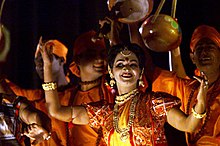ഭവയ്യ
വടക്കൻ ബംഗാളിൽ, പ്രത്യേകിച്ച് ബംഗ്ലാദേശിലെ രംഗ്പൂർ ഡിവിഷൻ, പശ്ചിമ ബംഗാളിലെ കൂച്ച് ബെഹാർ ജില്ല, ഇന്ത്യയിലെ അസമിലെ അവിഭക്ത ഗോൾപാറ ജില്ല എന്നിവിടങ്ങളിൽ നിന്ന് ഉത്ഭവിച്ച ഒരു സംഗീത രൂപമോ ജനപ്രിയ നാടോടി സംഗീതമോ ആണ് ഭവയ്യ.[4][5][6][7][8] പാപ്പാന്മാർ (ആനയെ പരിശീലിപ്പിക്കുന്നവരും പിടിക്കുന്നവരും), മഹിഷലുകൾ (എരുമകളെ മേയ്ക്കുന്നവർ), ഗരിയലുകൾ (വണ്ടി ഓടിക്കുന്നവർ) എന്നിവരടങ്ങിയ ഒരു "തൊഴിലാളി വർഗ്ഗ" സംഗീതത്തിലെ ഗാനങ്ങളുടെ വരികൾ അവരുടെ സ്ത്രീകളുടെ വേർപിരിയലിന്റെയും ഏകാന്തതയുടെയും [9]വേദനയും "ആഴത്തിലുള്ള വികാരവും" ഉയർത്തിക്കാട്ടുന്ന നീണ്ട സ്വരങ്ങളോടെ പ്രകടിപ്പിക്കുന്നു.[10] 16-ആം നൂറ്റാണ്ടിൽ കൊച്ച് രാജാവായ വിശ്വ സിംഹയുടെ കീഴിലാണ് ഉത്ഭവിച്ചതെന്ന് പൊതുവെ വിശ്വസിക്കപ്പെടുന്നു. [11] ഇത് 1950-കൾ മുതൽ സ്റ്റേജ് അവതരണങ്ങളായി പരിണമിച്ചു. 1990-കൾ മുതൽ ഇത് വ്യാപകമായി. ഭവയ്യ ഗാനങ്ങളുടെ വരികൾ മതവിഭാഗങ്ങളല്ലാത്തതാണ്.[12]
| Music of Bangladesh | |
|---|---|
 | |
| Genres | |
| Specific forms | |
| Religious music | |
| Ethnic music | |
| Traditional music | |
| Media and performance | |
| Music awards | |
| Music festivals | |
| Music media | Radio
Television Internet |
| Nationalistic and patriotic songs | |
| National anthem | Amar Shonar Bangla |
| Other | Notuner Gaan (National March) Ekusher Gaan (Ode to the Language Movement) |
| Regional music | |
| Related areas | |
| Other regions | |
| Music of West Bengal | |
|---|---|
 Baul Song Performing in Birbhum, West Bengal | |
| Genres | |
| |
| Specific forms | |
| Religious music | |
| Ethnic music | |
| Traditional music | |
| Media and performance | |
| Music media | Radio
Television Internet |
| Regional music | |
| Related areas | |
| Other regions | |
ഭവയ്യ എന്ന പേരിന്റെ ഉത്ഭവം
തിരുത്തുകഭവയ്യ എന്നതിന്റെ അർത്ഥത്തിന് വിവിധ വിശദീകരണങ്ങളുണ്ട്. കുറ്റിച്ചെടികളും മറ്റ് പച്ചക്കറികളും ഉള്ള താഴ്ന്ന പ്രദേശത്തെ ഭാവ എന്ന് വിളിക്കുന്നു. എരുമ സൂക്ഷിപ്പുകാർ ഉഴുമ്പോൾ ഈ പാട്ട് പാടുമായിരുന്നു. അങ്ങനെയാണ് ഭവയ്യ എന്ന പേര് ഉണ്ടായത്. മറ്റ് ചില ഗവേഷകരുടെ അഭിപ്രായത്തിൽ, ബവയ്യ എന്ന വാക്കിൽ നിന്നാണ് ഭവയ്യ ഉരുത്തിരിഞ്ഞത്. അത് പിന്നീട് ബാവോ (കാറ്റ്) എന്ന വാക്കിൽ നിന്നാണ് ഉരുത്തിരിഞ്ഞത്. ഭാവയ്യ എന്ന വാക്കിന്റെ വ്യുൽപ്പന്നം ഭാവ് > ഭോ + ഇയ = ഭവയ്യ എന്നാണ്. അതിനാൽ ഈ വാക്കിന്റെ ഉത്ഭവ അർത്ഥം വൈകാരികമായി നിറച്ചതാണ്. ശ്രദ്ധേയനായ ഗായകനും ഭവയ്യ ഗാനത്തിന്റെ സംഗീതസംവിധായകനുമായ അബ്ബാസ് ഉദ്ദീൻ പറയുന്നതനുസരിച്ച്, ഈ ഗാനം വടക്കൻ ബംഗാളിൽ നിന്ന് വീശുന്ന ക്രമരഹിതവും മനോഹരവുമായ കാറ്റ് പോലെയാണ്. ഇതിന് ഭാവയ്യ എന്നാണ് പേര് നൽകിയിരിക്കുന്നത്. ഒരു സർവേ പ്രകാരം (പശ്ചിമ ബംഗാൾ ഗവൺമെന്റ് ഓഫ് ഫോക്ക് കൾച്ചറൽ ആൻഡ് ട്രൈബൽ കൾച്ചറൽ സെന്റർ നടത്തിയതാണ്) ഭവയ്യ ഗാനം അവതരിപ്പിക്കുന്നവർക്കിടയിൽ ഈ പേര് ഭാവോ > ഭാവ് എന്ന വാക്കിൽ നിന്നാണ് ഉരുത്തിരിഞ്ഞത്. ഈ ഗാനങ്ങൾ ബിരാഹ അല്ലെങ്കിൽ വേർപിരിയലിന്റെയും ഏകാന്തതയുടെയും ആഴത്തിലുള്ള "വികാരങ്ങൾ" വഹിക്കുന്നു.[13]
ഫിലിം
തിരുത്തുകബംഗ്ലാദേശി ചലച്ചിത്ര സംവിധായകൻ ഷാനവാസ് കക്കോലിയുടെ ഉത്തരേർ സുർ (നോർത്തേൺ സിംഫണി) എന്ന സിനിമ ഒരു ഭാവയ്യ ഗായകന്റെ ജീവിതത്തെ അടിസ്ഥാനമാക്കിയുള്ളതാണ്, ദാരിദ്ര്യം മൂലം ബംഗ്ലാദേശിന്റെ വടക്കൻ ഭാഗത്ത് ഈ സംഗീതം ക്രമേണ നശിച്ചതിന്റെ കഥയാണ് പറയുന്നത്. പതിനെട്ടാമത് കൊൽക്കത്ത അന്താരാഷ്ട്ര ചലച്ചിത്രമേളയിൽ ചിത്രം പ്രദർശിപ്പിച്ചിരുന്നു.[14]
അവലംബം
തിരുത്തുക- ↑ "639 Identifier Documentation: aho – ISO 639-3". SIL International (formerly known as the Summer Institute of Linguistics). SIL International. Retrieved 2019-06-29.
Ahom [aho]
- ↑ "Population by Religious Communities". Census India – 2001. Ministry of Home Affairs, Government of India. Retrieved 2019-07-01.
Census Data Finder/C Series/Population by Religious Communities
- ↑ "Population by religion community – 2011". Census of India, 2011. The Registrar General & Census Commissioner, India. Archived from the original on 25 August 2015.
- ↑ "Bhawaiya". Banglapedia. Retrieved 29 May 2020.
- ↑ Rahman, Urmi. (2014). Bangladesh - culture smart! : the essential guide to customs & culture. Kuperard. p. 121. ISBN 978-1-85733-696-2. OCLC 883354783.
- ↑ Ahmed, A. F. Salahuddin; Chowdhury, Bazlul Mobin (2004). Bangladesh, national culture, and heritage : an introductory reader. University of Michigan. p. 407. ISBN 984-8509-00-3. OCLC 56598621.
- ↑ Khāna, Mobāraka Hosena (1988). Music and its study. New Delhi: Sterling Publishers. p. 69. ISBN 81-207-0764-8. OCLC 18947640.
- ↑ "The Goalpariya folk music genre (which combines both song and dance), originating in the Goalpara region of Assam, contains several characteristic yet diverse themes, principally spirituality, longing, desire, and separation. Based on these themes, the songs and dances are categorized into different groups. Two important categories of Goalpariya lokageet (the Assamese term for folk music) are bhawaiya and chatka." (Sarma & Monteiro 2019:331)
- ↑ "(T)he popular image that the term bhawaiya still conjures up is a form of plaintive ballads that speak of love and loss and endless longing within a woman’s heart." (Dutta 2019a)
- ↑ (Sarma & Monteiro 2019:332)
- ↑ "There is an approximate consensus that the origins of the form may be dated back to at least the sixteenth century, during the reign of Raja Bishwa Sinha, who established the kingdom of Koch Bihar."(Dutta 2019a)
- ↑ "(B)hawaiya developed as an integral cultural expression of the Rajbanshis, and these songs are composed in Rajbanshi (or Kamrupi or Kamtapuri), the most widely spoken Bengali dialect across this belt. Despite the influence of Brahminical Hinduism, Islam and Vaishnavism over the preceding centuries, the popular culture of these communities has retained matriarchal influences, evident from the many extant folk rituals and practices." (Dutta 2019a)
- ↑ "[W]hen mahouts went away (often to Bhutan, which was close to Goalpara and is sometimes mentioned in the songs) to catch the elephants, they were unable to return home for six months to a year. Their wives, who stayed at home, would express the pangs of separation and loneliness through these lokageet. Hence, the element of biraha, ‘deep emotion’, comes out very strongly through such songs." (Sarma & Monteiro 2019)
- ↑ "Bangladeshi filmmaker idolises Ritwik Ghatak". News Track India. Nov 13, 2012. Archived from the original on 22 February 2014. Retrieved 2 December 2012.
ഗ്രന്ഥസൂചിക
തിരുത്തുക- Dutta, Soumik (24 December 2019a). "The Solitude of Love: Nature, Culture and Womanhood in Bhawaiya Songs". Sahapedia. Archived from the original on 6 July 2020. Retrieved 6 July 2020.
- Dutta, Soumik (24 December 2019b). "The Bhawaiya Musical Tradition of West Bengal". Sahapedia. Archived from the original on 7 July 2020. Retrieved 7 September 2020.
- Sarma, Simona; Monteiro (2019). "Contemporary 'Folk' Dynamics: Shifting Visions and Meanings in the Goalpariya Folk Music of Assam". Folklore. 130 (4): 331–351. doi:10.1080/0015587X.2019.1622923.